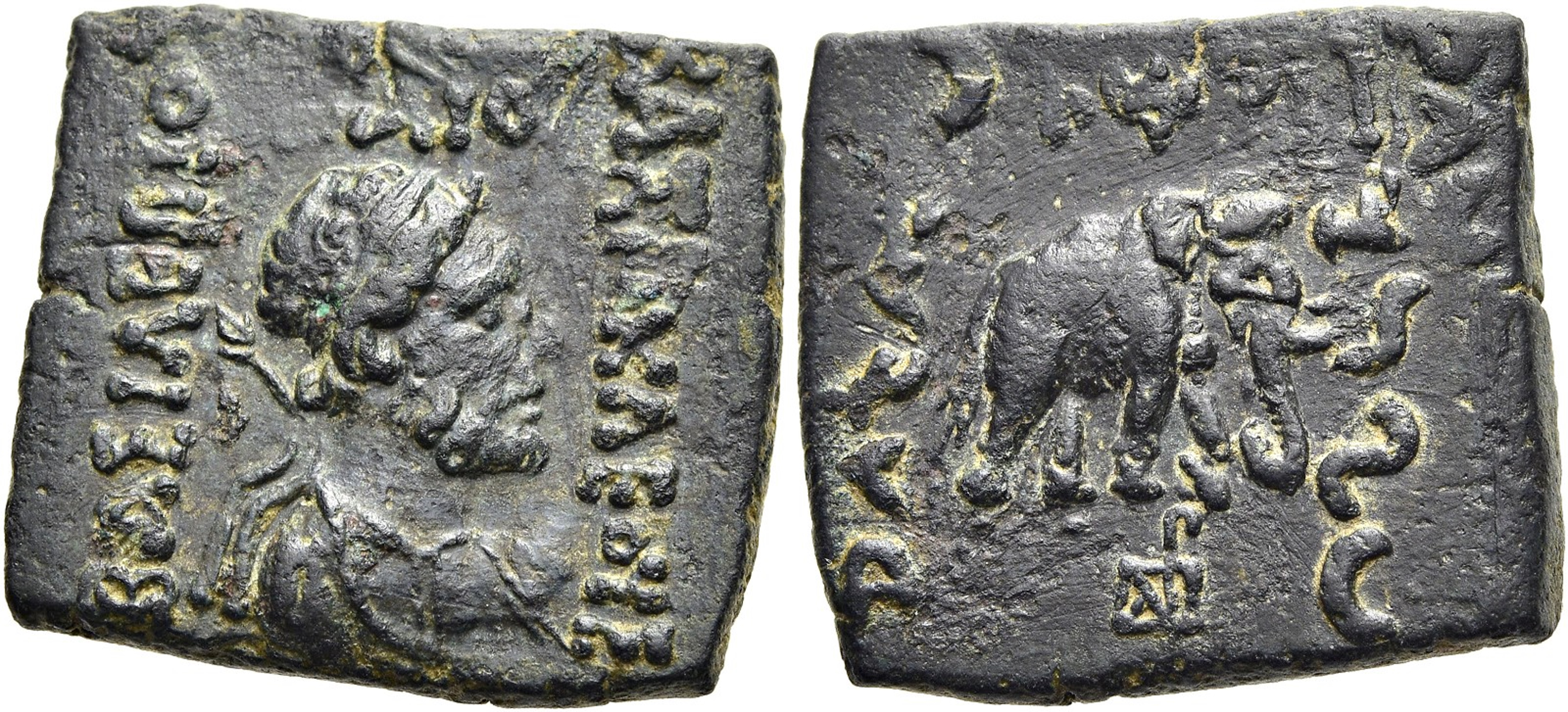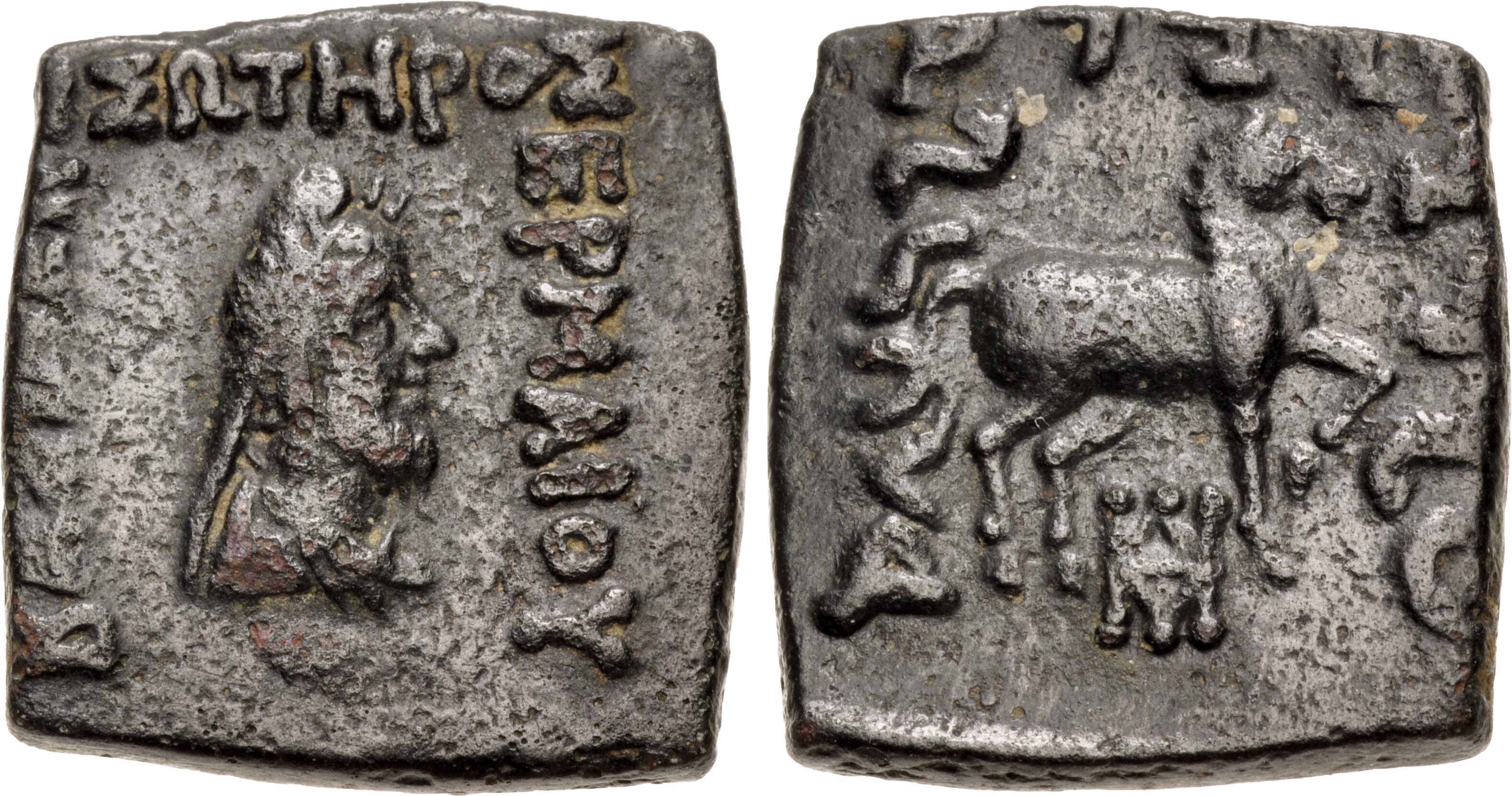89 BCE - 75 BCEΒΑΣΙΛΕΩΣ ΔΙΚΑΙΟΥ ΗΛΙΟΚΛΕΟΥΣ | Maharajasa dhramikasa Heliyakreyasa (of Great king Heliokles the Just)
Overstriking coin
Heliocles_II_over_Hermaeus_Gorny_&_Mosch, _297, _9_Oct._2023, _400.jpg
[1]
Overstruck variety
Hermaios Zeus–Mithras.jpeg
[2]
|
|
Sale(s)Sale(s) ᵖ:
|
Gorny & Mosch, 297, 9 Oct. 2023, 400
|
|
|
|
Description
| ObverseInscription or printing placed on the obverse.:
|
ΒΑΣΙΛΕΩΣ ΔΙΚΑΙΟΥ ΗΛΙΟΚΛΕΟΥΣ (Greek) Diademed, draped bust of Zeus right.
|
ReverseInscription or printing placed on the reverse.:
|
Maharajasa dhramikasa Heliyakreyasa (of Great king Heliokles the Just) (Kharoshthi) Elephant walking right. In exergue, monogram.
|
Mint and issuing power
Chronology
| FromIdentifies the initial date in a range assigned in a numismatic context. 89 BCE toIdentifies the final date in a range assigned in a numismatic context.. 75 BCE
|
Hellenistic 323-30 BC  periodTime period of the numismatic object. periodTime period of the numismatic object.
|
Physical description
MetalThe physical material (usually metal) from which an object is made.: Bronze 
|
WeightWeight of the numismatic object (in grams). in grams: 8.828.82 g <br />8,820 mg <br />
|
DenominationTerm indicating the value of a numismatic object. Examples: tetradrachm, chalkous, denarius.: denomination B
|
|
| DiameterDescribes diameter of an object (in mm).: 2222 mm <br />2.2 cm <br />
|
StandardStandard.: Indian
|
References
Description
| ObverseInscription or printing placed on the obverse.:
|
ΒΑΣΙΛΕΩΣ ΣΩΤΗΡΟΣ ΕΡΜΑΙΟΥ (Greek) Bust of Zeus-Mithraios right, wearing drappery and diadem
|
ReverseInscription or printing placed on the reverse.:
|
Maharajasa tratarasa Heramayasa (of the Great King Hermaios the Savior) (Kharoshthi) Horse advancing right, foreleg raised. In field, monogram
|
Mint and issuing power
Chronology
| FromIdentifies the initial date in a range assigned in a numismatic context. 100 BCE toIdentifies the final date in a range assigned in a numismatic context.. 90 BCE
|
Hellenistic 323-30 BC  periodTime period of the numismatic object. periodTime period of the numismatic object.
|
Physical description
| DenominationTerm indicating the value of a numismatic object. Examples: tetradrachm, chalkous, denarius. ᵖ:
|
denomination B
|
StandardStandard. ᵖ:
|
Indian
|
References
| Frequency of overstrikesFrequency of overstrikes:
|
frequent
|
Level of confidenceLevel of confidence of the identification:
|
sure
|
| RemarksRemarks:
|
"Überprägt auf eine Münze des Hermaios (Bopearachchi 9A - oben auf dem Revers sind, auf dem Kopf stehend, die Hinterbeine des Pferdes und das runde Monogramm erkennbar)"
|
References
- a b Mitchiner, Michael (1975), Indo-Greek and Indo-Scythian coinage, London,
- a b Bopearachchi, Osmund (1991), Monnaies gréco-bactriennes et indo-grecques : catalogue raissoné, Paris, 459 p., 69 pl.
- a b Hoover, Oliver D. (2013), Handbook of coins of Baktria and ancient India : including Sogdiana, Margiana, Areia, and the Indo-Greek, Indo-Skythian, and native Indian states south of the Hindu Kush, fifth century BC to first century, Lancaster-London,

